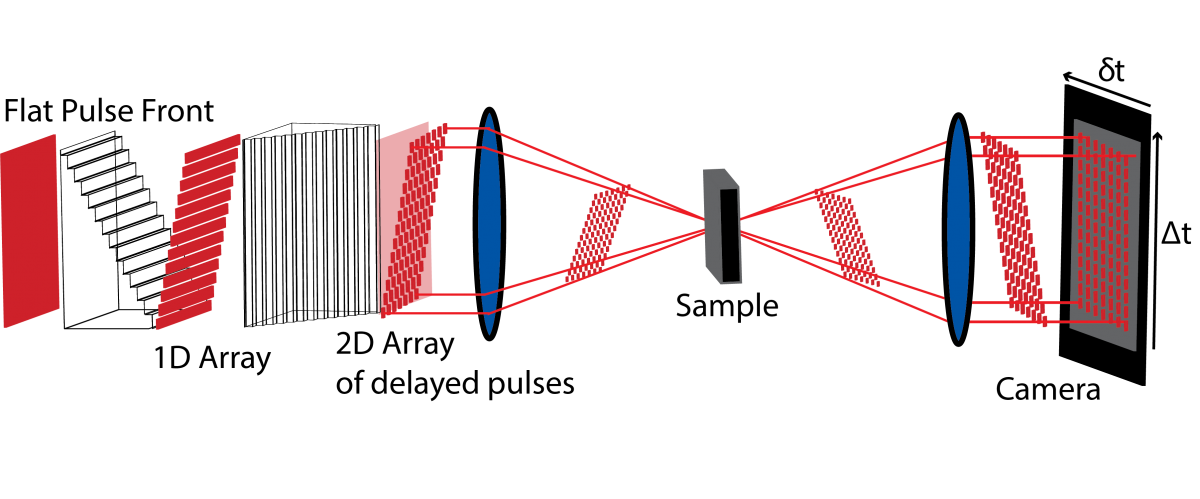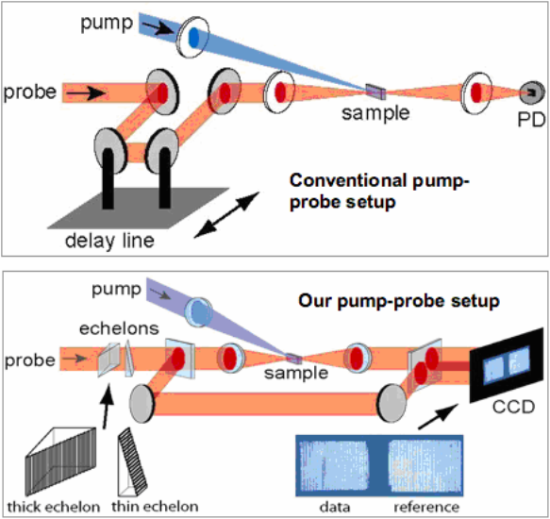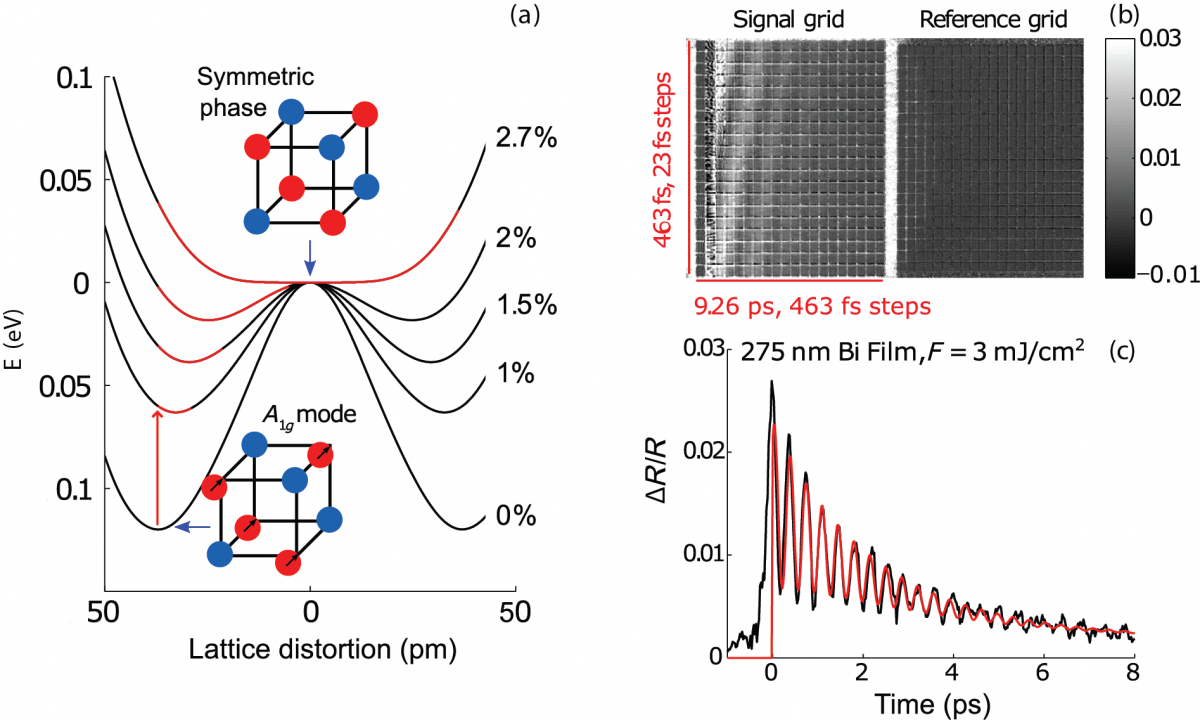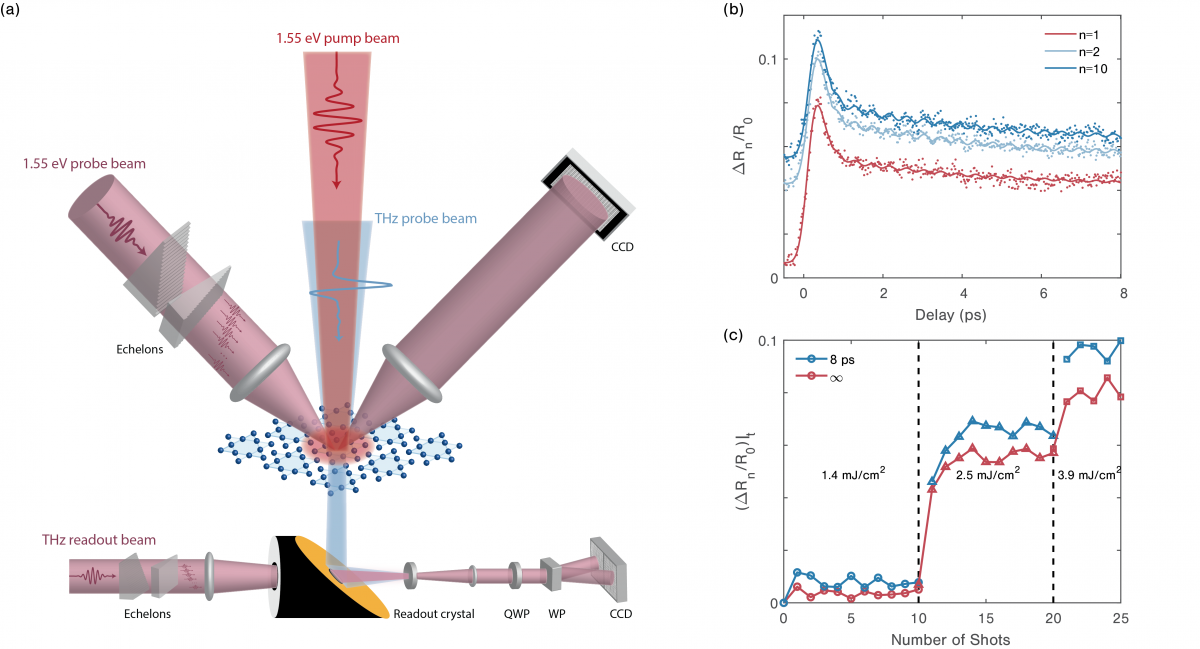Beyond conventional stroboscopic pump-probe spectroscopy
Many structural and chemical dynamics in the solid state occur irreversibly and with a build-up of reaction products. Irreversible or long-lived solid-state dynamics cannot be studied using conventional ultrafast spectroscopy, in which repeated measurements are made on a sample that returns to its initial state after each laser shot. We have developed a novel method for real-time measurement of ultrafast dynamical events in a single laser shot. An excitation laser pulse is followed by 400 probe pulses, which arrive at the sample at different times and at slightly different angles. Figure 1 below illustrates the generation of a time-structured probe pulse. The crossed echelons transform the input pulse into a 2D array of spatially and temporally resolved pulses. Each probe pulse, after transmission through or reflection off the sample, arrives at a different region of a CCD camera. Thus a single laser shot yields a complete time-dependent record of the sample response.

Figure 1:Crossed-echelon method
Figure 2 illustrates how our setup differs from the conventional pump-probe setup. The pump-probe setup (a) employs a delay line to achieve time-resolution, where the pump and probe pulses are separated by a varying time delay. In the single-shot setup (b) there is no delay line. The time resolution, set by the echelon thickness, is 25 femtoseconds. This technique provides a real-time picture of chemical and structural dynamics in a single shot.

Figure 2: Comparison of conventional pump-probe experiment and single-shot experiment
Photochemistry in Organic Crystals
We employed single-shot femtosecond spectroscopy to study the effect of the surrounding lattice structure on the photodissociation and recombination of the triiodide ion (I3-). The panels on the left of Figure 3 illustrate the structures of three different organic crystals (tetrabutylammonium triiodide: TBAT, tetraethylammonium triiodide: TEAT, and tetraphenylphosphonium triiodide: TPPT). The different crystal structures provide different circumstances to the reactant. The panels on the right of Figure 3 show the transient absorption spectra of photofragment I2- after photolysis of triiodide in the corresponding crystals. As shown, the dynamics of dissociation and recombination differ dramatically depending on the environment. This example demonstrates the significance of lattice structure on solid state photochemistry as well as the potential of single-shot femtosecond spectroscopy as a tool for the study of irreversible solid state dynamics. For more details, see reference [7]. Recently, we have looked into the response of the lattice to photodissociation of triiodide. Raman scattering of lattice excitations following photodissociation may be visible with the single-shot instrument, and would give a more complete picture of how the surrounding environment mediates photochemistry.

Figure 3: Transient absorption spectra of three triiodide crystals.
Photoinduced Phase Transitions in Semimetals
Using a single-shot, real-time measurement method, we are able to observe the photoinduced phase transition from the semimetallic, low-symmetry phase of crystalline bismuth into a high-symmetry phase whose existence at high electronic excitation densities is predicted based on earlier measurements at moderate excitation densities below the damage threshold. Our observations indicate that coherent lattice vibrational motion launched upon photoexcitation with an incident fluence above 10 mJ/cm2 in bulk bismuth brings the lattice structure directly into the high-symmetry configuration for several picoseconds, after which carrier relaxation and diffusion restore the equilibrium lattice configuration.

Figure 4: Dual-echelon single-shot spectroscopy of bismuth.
Snapshots of a light-induced metastable hidden phase
Nonequilibrium hidden states, both transient and long-lived, provide a unique window into thermally inaccessible regimes of strong coupling between microscopic degrees of freedom in quantum materials. Understanding the physical origin of these states is of both fundamental and practical significance, allowing the exploration of far-from-equilibrium thermodynamics and the development of optoelectronic devices with on-demand photoresponses. However, mapping the ultrafast formation of a long-lived hidden phase remains a long-standing challenge in physics since the initial state of the system is not recovered rapidly and conventional pump-probe methods are thus not applicable. Using a suite of state-of-the-art single-shot spectroscopy techniques, we present a direct ultrafast visualization of the photoinduced phase transition to both transient and long-lived hidden states in an electronic crystal, 1T-TaS2. Capturing the dynamics of this complex phase transformation in a single-shot fashion demonstrates a commonality in microscopic pathways, driven by the collapse of charge order, that the system undergoes to enter the hidden state and provides unambiguous spectral fingerprints that distinguish such state from thermally accessible phases.

Figure 5: Light-induced metastable hidden phase in 1T-TaS2 revealed by dual-echelon single-shot optical reflectivity and THz transmission spectroscopy.
Multidimensional THz spectroscopy with high-speed, shot-to-shot, balanced detection
By using a reflective-echelon-based electro-optic sampling technique and a fast detector, we develop a two-dimensional terahertz (THz) spectrometer capable of shot-to-shot balanced readout of THz waveforms at a full 1-kHz repetition rate. The development shows a two-order-of-magnitude speedup in the acquisition of multidimensional THz spectra when compared to conventional delay-scan methods while maintaining accurate retrieval of the nonlinear THz signal. Our approach presents a feasible solution for bringing the technique of multidimensional THz spectroscopy into widespread practice.

Figure 6: Two-dimensional terahertz spectroscopy setup with single-shot readout.
References
1. "Spatially-encoded, single-shot ultrafast spectroscopies," J.T. Fourkas, L. Dhar, K.A. Nelson, and R. Trebino, J. Opt. Soc. Am. B 12, 155-165 (1994). [url]
2. "Pulse-length-limited ultrafast pump/probe spectroscopy in a single laser shot," L. Dhar, J.T. Fourkas, and K.A. Nelson, Opt. Lett. 19, 643 (1994). [url]
3. "Single-shot femtosecond spectroscopy of reactive organic molecular crystals," W. Wang, D.D. Chung, J.T. Fourkas, L. Dhar, and K.A. Nelson, in Proc. 2nd Int'l. Workshop on Microscopic and Macroscopic Approaches to Detonation, St. Malo, 1-10 October 1994, J. de Phys. IV Colloque C4, supplement au J. de Phys. III, v. 5, May 1995.
4. "Dual-echelon single-shot femtosecond spectroscopy," G.P. Wakeham and K.A. Nelson, Opt. Lett. 25, 357-363 (2000). [url]
5. "Femtosecond time-resolved spectroscopy of energetic materials," G.P. Wakeham, D.D. Chung, and K.A. Nelson, Thermochimica Acta 384, 7-21 (2001). [url]
6. "Single-shot transient absorption of I3- in solutions and glasses," P.R. Poulin and K.A. Nelson, in Ultrafast Phenomena XIV, T. Kobayashi, T. Okada, T. Kobayashi, K.A. Nelson, and S. De Silvestri , eds. (Springer-Verlag, Berlin 2005), pp. 529-531. [url]
7. "Irreversible organic crystalline chemistry monitored in real time," P.R. Poulin, and K.A. Nelson, Science 291, 1756 - 1760 (2006). [url]
8. "Dual Echelon Femtosecond Single-Shot Spectroscopy," T. Shin, J.W. Wolfson, S.W. Teitelbaum, M. Kandyla, and K.A. Nelson, Rev. Sci. Inst. 85, 083115 (2014). [url]
9. "Cooperative photoinduced metastable phase control in strained manganite films," J. Zhang, X. Tan, M. Liu, S. W. Teitelbaum, K. W. Post, F. Jin, K. A. Nelson, D. N. Basov, W. Wu and R. D. Averitt, Nat. Mater. 15, 956–960 (2016) [url]
10. "Coherent control of optical phonons in bismuth," Y. Cheng, F. Y. Gao, S. W. Teitelbaum, and K. A. Nelson, Phys. Rev. B 96, 134302 (2017) [url]
11. "Long-lived photoinduced response observed under extreme photoexcitation densities in a one-dimensional Peierls insulator," J. Wolfson, T. Shin, S. W. Teitelbaum, I. Katayama, T. Kawano, J. Takeda, K. A. Nelson, Phys. Rev. B 98, 054111 (2018) [url]
12. "Real-time observation of a coherent lattice transformation into a high-symmetry phase," S. W. Teitelbaum*, T. Shin*, J. W. Wolfson, Y.-H. Cheng, I. J. Porter, M. Kandyla, and K. A. Nelson, Phys. Rev. X 8, 031081 (2018) [url]
13. "Femtosecond laser amorphization of tellurium," Y.-H. Cheng, S. W. Teitelbaum, F. Y. Gao, and K. A. Nelson, Phys. Rev. B 98, 134112 (2018) [url]
14. "Snapshots of a light-induced metastable hidden phase driven by the collapse of charge order", F. Y. Gao*, Z. Zhang*, Z. Sun, L. Ye, Y.-H. Cheng, Z.-J. Liu, J. G. Checkelsky, E. Baldini, K. A. Nelson, Sci. Adv. (2022) [url]
15. "High-speed two-dimensional terahertz spectroscopy with echelon-based shot-to-shot detection," F. Y. Gao*, Z. Zhang*, Z.-J. Liu, K. A. Nelson, Opt. Lett. (2022) [url]
